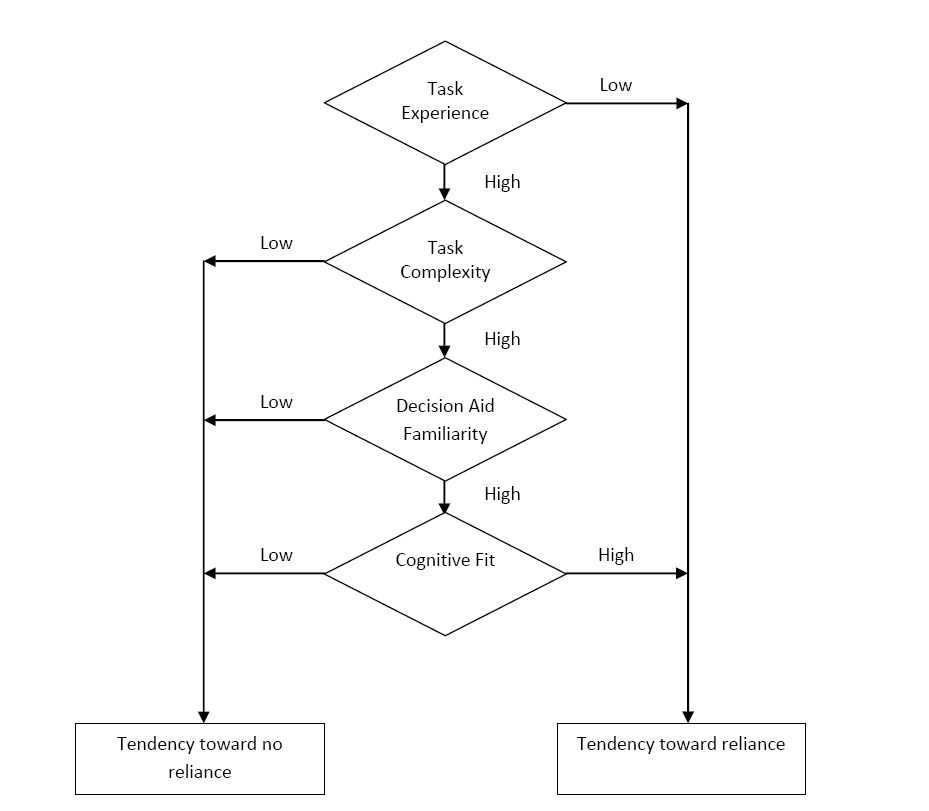Technology dominance, theory of - IS Theory

Theory of Technology Dominance
Acronym
TTD
Alternate name(s)
Not applicable
Main dependent construct(s)/factor(s)
TTD has two dependent factors:
- Reliance - The extent to which and individual applies the intelligent decision aid and integrates the recommendations of that aid into his or her judgment.
- Dominance - The state of decision making where the intelligent decision aid, as opposed to its user, takes primary control of a decision making process.
Main independent construct(s)/factor(s)
TTD has four independent factors:
- Task Experience - The level of experience a decision maker has regarding the completion of a task as well as the extent to which the decision maker has developed strategies for completing that particular task.
- Task Complexity - The extent to which the cognitive abilities of the decision maker are challenged with completing a certain task. (In psychology this is often termed Task Difficulty.)
- Decision Aid Familiarity - The extent to which the decision maker is comfortable with the intelligent decision aid based on prior experience and/or significant training with the aid (or similar aids).
- Cognitive Fit – The extent to which the cognitive processes used with the decision aid to complete a task match the cognitive processes normally applied by the decision maker using the aid.
Concise description of theory
The Theory of Technology Dominance (TTD) posits that a decision maker may become reliant on an intelligent decision aid under two conditions:
- The decision maker is low in task experience (see independent factors).
- The decision maker is high in all factors (task experience, task complexity, decision aid familiarity, and cognitive fit).
According to TDD, reliance on an intelligent decision aid can create a long-term, de-skilling effect in the user as well as hinder that user’s growth of knowledge and advancement in his or her domain. Furthermore, TDD states that a negative relationship exists between the user’s expertise level and the risk of poor decision making when the expertise of the user and intelligent decision aid are mismatched. When the expertise of the user and the aid are matched, however, a positive relationship exists between reliance on the aid and improved decisions making.
Conceptually, TTD can be divided into three sections which are built on a total of eight testable propositions. The three sections are:
- Section 1: Addresses the factors that determine the likelihood that a decision maker will rely on an intelligent decision aid.
- Section 2: Addresses the conditions under which a decision maker is vulnerable to being dominated by the intelligent decision aid.
- Section 3: Addresses the long-term impact of intelligent decision aid use on de-skilling domain experts and impeding epistemological evolution.
The eight testable propositions are (Arnold & Sutton, 1998):
- Section 1 - Factors influencing reliance
- Proposition 1: “When users have a low to moderate level of experience, there is a negative relationship between task experience and reliance on a decision aid."
- Proposition 2: “There is a positive relationship between task complexity and reliance on a decision aid.”
- Proposition 3: “When task experience and perceived task complexity are high, there is a positive relationship between decision aid familiarity and reliance on the decision aid.”
- Proposition 4: “When task experience and perceived task complexity are high, there is a positive relationship between cognitive fit and reliance on the decision aid."
- Section 2 – Conditions favorable for dominance
- Proposition 5: “When the expertise of the user and intelligent decision aid are mismatched, there is a negative relationship between the user’s expertise level and the risk of poor decision making."
- Proposition 6: “When the expertise level of the user and intelligent decision aid are matched, there is a positive relationship between reliance on the aid and improved decisions making."
- Section 3 – Long-term effects
- Proposition 7: “There is a positive relationship between continued use of an intelligent decision aid and the de-skilling of auditors’ abilities for the domain in which the aid is used."
- Proposition 8: “There is negative relationship between the broad-based, long-term use of an intelligent decision aid in a given problem domain and the growth in knowledge and advancement of the domain.”
Diagram/schematic of theory
Recreated from Arnold and Sutton (1998)
Originating author(s)
Vicky Arnold and Steve Sutton
Seminal articles
Originating Article
- Arnold, V., & Sutton, S.G. (1998). The theory of technology dominance: understanding the impact of intelligent decision aids on decision makers' judgments. Advances in Accounting Behavioral Research, 1, 175-194.
Tests of the Theory
- Masselli, J. J., Rickets, R. C., Arnold, V., & Sutton, S. G. (2002). The impact of embedded intelligent agents on tax-reporting decisions. Journal of the American Taxation Association, 24 (2), 60-78. - Tested 5th and 6th propositions of TTD.
- Noga, T., & Arnold, V. (2002). Do tax support systems affect the accuracy of tax compliance decisions? International Journal of Accounting Information Systems, 3, 125-144. - Tested 5th and 6th propositions of TTD.
- Arnold, V., Collier, P. A., Leech, S. A., & Sutton, S. G. (2004). Impact of intelligent decision aids on expert and novice decision-makers' judgments. Accounting and Finance, 44, 1-26. - Tested 5th and 6th propositions of TTD.
- Hampton, C. (2005). Determinants of reliance: an empirical test of the theory of technology dominance. International Journal of Accounting Information Systems, 6, 217-240. - Tested first four propositions of TTD.
- Dowling, C., Leech S.A., Maroney, R. (2006). The deskilling of auditors’ abilities: An empirical test of the theory of technology dominance. 2nd Asia- Pacific Research Symposium on Accounting Information Systems. - Tested 7th proposition of TTD
- Hunton, J., Arnold, V., & Reck, J.L. Decision aid reliance: a field study involving professional buy-side financial analysts. Contemporary Accounting Research, Forthcoming. – Tested 2nd proposition of TTD
Originating area
Information Systems
Level of analysis
Individual
IS articles that use the theory
- Noga, T., & Arnold, V. (2002). Do tax support systems affect the accuracy of tax compliance decisions? International Journal of Accounting Information, 3, 125-144.
- Hampton, C. (2005). Determinants of reliance: an empirical test of the theory of technology dominance. International Journal of Accounting Information Systems, 6, 217-240.
- Arnold, V., Clark, N., Collier, P. A., Leech, S. A., & Sutton, S. G. (2006). The differential use and effect of knowledge-base system explanations in novice and expert judgment systems. MIS Quarterly, 30 (1), 79-97.
- Mascha, M. F., & Smedly, G. (2007). Can computerized decision aids do "damage"? A case for tailoring feedback and task complexity based on task experience. International Journal of Accounting Information Systems, 8, 73-91.
- Al-Natour, S., Benbasat, I., & Cenfetelli, R.T. (2008). The effects of process and outcome similarity on user's evaluations of decision aids. Decision Sciences, 39(2), 175-211.
Links from this theory to other theories
Psychology
- Theory of Cognitive Fit (Vessey, 1991)
- Cognitive Load Theory (Sweller, 1988)
Sociology
- Innovation Diffusion Theory (Rogers, 1962)
Information Systems
- Technology Acceptance Model (Davis, 1989)
- Model of PC Utilization (Thompson et al., 1991)
Philosophy of Science/Rhetoric
- Toulmin’s Model of Argumentation (Toulmin, 1958)
External links
Presentation of TTD by one of the originating authors[[1]]
Original Contributor(s)
Andrew Dill, University of Central Florida
Please feel free to make modifications to this site. In order to do so, you must register.
Return to Theories Used in IS Research
Media:Example.ogg
